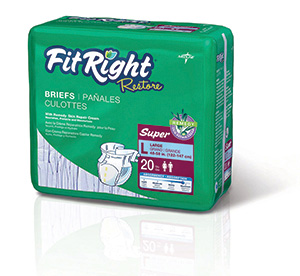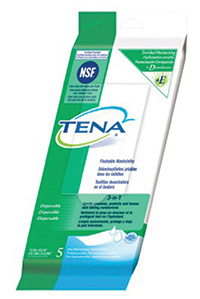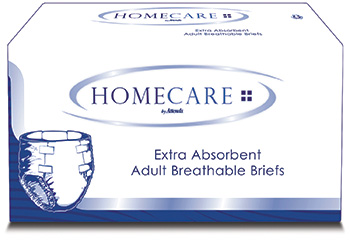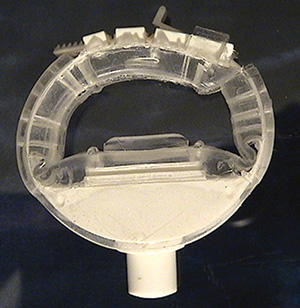Incontinence isn’t just a problem of the elderly. It affects people of all ages at all stages of life. Many people suffer in silence, have trouble understanding the causes and don’t know where to find answers. Overcoming misconceptions about incontinence involves engaging consumers and caregivers through educational literature and candid conversations. “Meeting consumer needs will result in a satisfied customer and increased sales for the provider,” says Teresa Coles, director of government and home care sales for SCA Personal Care, North America. Responsiveness to customer needs is a critical aspect of success in the incontinence market. For example, SCA Personal Care works directly with consumers to gain their insight. More individuals with incontinence prefer to stay in their homes as long as possible—and managing costs along with the level of care are important. “A key is to ensure that patients have access to the right product that offers the right protection based on their level of incontinence, and whether they can put on and remove the products themselves or require assistance,” says Coles. SCA’s Tena line is expanding to accommodate various situations and individual needs, just one example of the wealth of incontinence product choices for consumers. HME providers are positioned to guide consumers through the choices. “We believe the best way to sell incontinence products is to truly understand incontinence,” says Bill Bowser, director of post-acute care sales for Medline’s Personal Care Division. “It’s a clinical issue, and the better HME providers understand what causes it and how it can be managed, the more value they will bring to their customers.” For example, if a customer has stress incontinence, a bladder control pad may be a better option than a brief. If HME providers ask the right questions, the end user is more likely to get the product most appropriate for them, says Bowser. Searching for ways to reduce costs and control fraud, many state Medicaid programs are moving to a health maintenance organization (HMO) managed care model. It’s an opportunity for providers and dealers to contract with new organizations to provide incontinence products. Many states are finding it hard to balance their budgets and are making significant cuts to Medicaid reimbursement rates that impact incontinence products. Manufacturers are developing products that meet and exceed state incontinence product testing requirements.
Increasing Retail Presence
SCA Personal Care in Philadelphia, a global leader in personal care products, has an extensive portfolio of incontinence, baby diapers and feminine care products. In the United States, SCA Personal Care’s Tena brand product categories include underpads, briefs, protective underwear and pads/liners. Tena also carries an assortment of skin care products to meet the needs of consumers and caregivers. Increasing the retail presence of incontinence products in your store is important, says Coles. This presence includes having a separate and easy system to order products while using smart, engaging shelving and merchandising solutions to display products. To help, SCA Personal Care has launched Tena Starters, kits for HME providers who want to sell incontinence products but don’t know where to start. Based on the available shelf space, a provider can select 2 x 2 or 2 x 4 kits, order via a single item number and Tena will provide a set of incontinence products they can quickly place on the shelf—pads, skin care, etc. Having the right merchandising solutions, such as planograms, shelf signs and educational materials, is equally important to create a customer-friendly environment. On the product front, Tena Flushable Washcloths offer gentle skin care for those with incontinence, cleansing and moisturizing skin and leaving it feeling clean and fresh. They are 99 percent biodegradable and the only adult-size disposable washcloth that has been certified as flushable by the National Sanitation Foundation. The washcloths break down completely to move through sewage, treatment and reuse systems, requiring less time and money for plumbing cleanups and repairs.
The Specific Needs of Home Care
 Medline's FitRight Restore Briefs include a layer of Remedy Skin Repair Cream on the core to help reduce IAD.
Medline's FitRight Restore Briefs include a layer of Remedy Skin Repair Cream on the core to help reduce IAD.Incontinence needs for home care patients are distinctive. The change rate tends to be higher, so home care patients need a low-cost incontinence product that performs well to absorb and hold initial wetness; re-wet performance is secondary, says Paul Pritchard, vice president of marketing for Attends Healthcare Products. In 2013, Attends launched Homecare Briefs by Attends, a new brief designed specifically with the home care user in mind. The new brief has excellent initial wetness performance, while providing great comfort and protection. Attends, headquartered in Greenville, N.C., offers a range of products for light to severe urinary and/or fecal incontinence for ambulatory and sedentary users. Designed for comfort, secure protection and healthy skin maintenance, the offerings of the broad line meet all sizes and lifestyle needs for women, men and youth.
 TENA product categories include underpads, briefs, protective underwear and pads/liners.
TENA product categories include underpads, briefs, protective underwear and pads/liners.Attends Supersorb Underpads improve outcomes while lowering costs. The all-in-one disposable underpads, for both patient and bed protection, reduce the need for multiple underpads. The soft product includes a cloth-like top sheet that covers the entire surface to promote healthy skin. A super-absorbent polymer is used to channel fluids and lock them away from skin for maximum protection and to control odor. Supersorb Underpads are air-permeable for patients with a high risk of skin breakdown. With so many adult incontinence (AI) products on the market, finding the right product can be challenging at times for HME providers but proves especially difficult for patients. “A number of issues in relation to AI products, such as leakage and skin health issues, can be addressed by simply providing the appropriate product and supplying the proper education on product application for end users,” says Pritchard.
 Attends Homecare Briefs were designed specifically with the home user in mind.
Attends Homecare Briefs were designed specifically with the home user in mind.“In many cases, a high quality product, which tends to cost more up front, will result in better wetness protection and skin care for the patient, reducing the cost of possible skin health-related issues that could develop in the future.”
Individualized Care, Superior Containment
A misconception related to incontinence products is that thicker means more absorbent, which isn’t always true, says Bowser of Medline in Mundelein, Ill. “Our new FitRight brief has a thin, comfortable and discreet core that is designed to stay dry,” he says. Customers also tend to ask about “total absorbency,” which doesn’t accurately demonstrate the quality of a product under normal usage. “We try to help them understand that better dryness in normal conditions is much more important than how much total fluid a product can hold,” he says. Medline offers a full line of incontinence care products, including adult and pediatric items such as briefs, pull-ups, liners and underpads. A new 650,000-square-foot facility just outside Atlanta is making an innovative brief called FitRight, which features a new design, better dryness and improved absorbency. The factory also manufactures the company’s pull-up line on the newest and most advanced machines in the industry, says Bowser. Medline’s FitRight Restore brief includes Medline’s Remedy Skin Repair Cream applied to the core of the product. The cream is distributed to the skin as body heat warms the product. In addition, it has also been shown to help reduce the instance of incontinence-associated dermatitis (IAD). The new design of the FitRight core and brief allows for a drier and better fit, which naturally leads to increased comfort for the user. The new layer of skin cream laid directly into the brief eliminates the extra application step, plus it helps solve patient skin issues associated with IAD. Medline’s products are designed to promote individualized care and superior containment. For example, homebound patients need products that will provide dryness over time and give the wearer the confidence they need to go about their daily business with less concern about leakage. “We are also focused on making products that have clinical benefits such as cooler skin, and more discreet products that are less obvious when worn,” says Bowser.
Selling More Incontinence Products
Pritchard of Attends offers several suggestions for ways that HME providers can sell more incontinence products to increase profits. One way is to offer multiple payment options, including insurance, Medicaid reimbursement and private pay (cash customers). Another factor to increase sales is a wide variety of products, based on product performance and on size—in other words, offer a high-end as well as a value-tier line of products. Samples and educational materials can also boost the adult incontinence category, as can strong customer service and product knowledge. “A staff should have complete product knowledge and be able to recommend products based on specific customer needs,” says Pritchard. “Having a solid product selection at the right price is the key,” he says. “Being aware of the products that are offered in national chain stores, and offering products that are missing from those store shelves or are harder to find, is always a good approach. It is also important to be sensitive to prices offered by the national chains.” Merchandising and displays are very important for providers to show what products they have available, according to Medline, which offers merchandising tools to help customers select the right products and enhance the buying experience, says Bowser. HME providers looking to expand into the market should recognize the differences among products, understand how the products work most effectively and identify how they can help a patient decide which product is best. Other strategies are to diversify the Medicare/Medicaid payer mix, and engage new channels of business, such as assisted living facilities, says Coles of SCA Personal Care.
Addressing Male Incontinence
Female urinary incontinence is three to five times more prevalent than male incontinence, so manufacturers tend to focus on female urinary incontinence products. Among men, there are more than 90,000 radical prostatectomy surgeries a year, and one consequence is incontinence for six months to two years after surgery.
 UroMend’s B.I.C.D. offers male users an
alternative to traditional products.
UroMend’s B.I.C.D. offers male users an
alternative to traditional products.Many male patients use diapers during that time and may not be aware that there are market alternatives, such as penile clamps. “How do you make a paradigm shift in the minds of the elderly?” asks Rahul Bakane, vice president of sales, UroMend, LLC. Penile clamps have been around for 50 years, but most of the devices currently on the market—reflecting improvements in materials, design, functionality and comfort—have been introduced within the last 10 years. UroMend, LLC manufactures the prescription-based B.I.C.D (Bakane Incontinence Control Device), a male urinary incontinence product. The penile clamp is one-size-fits all, doesn’t need to be removed for urination, doesn’t degrade from water and urine exposure, has no metal parts and is washable with soap and water. The negligible pressure exerted by the clamp is not uncomfortable. “Patients sometimes feel shame and have given up hope,” says Bakane. “Educating the patient will show them they could have regular day-to-day activities available to them. They don’t have to give up their social lives.” Bakane adds that the reputation of penile clamps is that they are uncomfortable or don’t work, but they are an effective product for the right patients. He acknowledges that newer products are slower to be accepted, especially if a large manufacturer has incumbency and/or substantial marketing clout. “I do see an avenue of opportunity for smaller manufacturers, but it’s a long, uphill battle, with promising results, if successful,” he says. Bakane urges HME providers to stay informed about new developments, but admits it’s difficult. “There’s too much information and not enough time to read everything,” he comments.
Complementary Skin Care Products
Skin care products are another retail opportunity for HME providers related to incontinence. As part of a display, Medline’s Dermal Management Systems Division offers a 32-ounce pump containing Remedy with Olivamine Skin Repair Cream, which allows customers to try it before they buy it. The display also has a 4-ounce tube for purchase. Medline offers 4-milliliter packets of its skin care products that can be sent out as samples to allow customers to touch and feel the products before purchase. Medline’s Remedy skin care line includes cleansers, moisturizers, barriers and protectants that nourish and hydrate the skin. Two of the Remedy formulations are Olivamine and Phytoplex, which both provide nourishment for the skin and are supported by more than 30 clinical studies with positive outcomes. Olivamine is a blend of olive extracts, amino acids, vitamins and antioxidants to help nourish and strengthen the skin. Phytoplex is a blend of all-natural ingredients from botanical and marine sources such as blue-green algae, clove, soy and green tea. It is free of aloe, parabens, phthalates and sulfates. Phytoplex is suitable for all types of skin, including the most sensitive skins, and has been tested to be effective for neonates and adults. The product hydrates, nourishes and strengthens at-risk skin and would be suitable for a number of skin issues, or anyone who is homebound or bedbound. Incontinence can cause dryness and irritation due to excess stool and urine on the skin. Medline’s Remedy with Phytoplex Hydraguard is a silicone-rich skin care formulation that creates a breathable, water-resistant film over skin as it moisturizes and nourishes. If the patient is wearing a brief, the product feels dry to the touch after being applied to the skin, which makes for a comfortable environment. Hydraguard reduces the appearance of red, cracked, and scaly skin while soothing dry itchy skin. Some customers may think they won’t like the feeling or scent of a skin care product designed to protect from incontinence, says Ashley Brust, product manager of Medline’s dermal management systems division. However, Medline’s Remedy product line smells pleasant and is also easy to use, affordable and preferred by a variety of end users.
